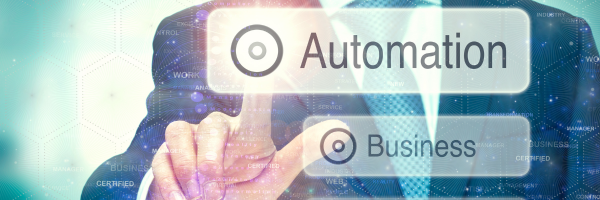By Chief Automation Officer, George K. Mehok
April 26th, 2023
In the Hyper-automation series, we explore the technologies that leading tech innovators are deploying to transform business operations, reduce the risk of regulatory non-compliance, and revolutionize the customer experience. There are six key infrastructure components necessary to achieve these results and create a data-driven autonomous workflow, including:
1) Process Discovery Tools
2) Event-Driven Integration Platform
3) Robotic process automation (RPA)
4) AI / Machine Learning
5) Data Visualization
6) Operational Monitoring and Alerting
In the first of the hyper-automation series, we reviewed Process Discovery Tools, Event-Driven Integration Platforms and Robotic Process automation. This article will cover Artificial Intelligence/Machine Learning and how it can be leveraged to enhance workflow automation.
CFOs and CIOs recognize that automation can significantly lower operating costs; however, a recent study concluded that 70% of companies have only 20% of processes automated. There are many reasons why the percentage of automated processes remains low: 1) Lack of organizational alignment, 2) Lack of resources 3) Lack of capabilities. Of these, “lack of capabilities” is difficult for tech leaders to overcome without clearly defining the automation technology platform requirements to enable hyper-automation and translate that understanding into a technology roadmap to direct resource allocation and project prioritization.
What is Hyper-automation?
Hyper-automation is a business-driven, disciplined approach that organizations use to rapidly identify, vet, and automate as many business and IT processes as possible. Hyper-automation involves the orchestrated use of multiple technologies, tools, or platforms[1].
Hyper-automation is the intersection of business process automation, service-oriented infrastructure, and artificial intelligence. The outcome can be transformational, resulting in efficiencies driving bottom-line financial success and customer satisfaction that exceeds legacy customer service metrics. Top-line revenue grows as the company’s resources are redeployed to internal innovation energy amplified as a catalyst to new products, services, and in some cases entire new market segments.
Gartner estimates that more than 56% of organizations have an average of four or more concurrent hyper-automation initiatives underway and leading companies have over ten. The continued growth of hyper-automation initiatives is taking root in organizations that have experienced success with basic tasks, implementation of enterprise service desk and CRM workflow apps, and legacy system conversation-oriented projects. However, achieving hyper-automation relies on the fusion of an integrated technology architecture and organizational design factors aimed at identifying, prioritizing, and managing automation projects.
While over 60% of companies use some form of business process automation and 24% have begun implementing low code process automation tools, companies must build a technology architecture incorporating access to the next generation of Artificial Intelligence capabilities.
[1] https://www.gartner.com/en/information-technology/glossary/hyperautomation
Artificial Intelligence / Machine Learning
The potential of future advancements in robotic process automation (RPA) is immense and ever-growing; however, when paired with artificial intelligence (AI) or machine learning (ML), the transformative business benefit becomes a reality. The combination creates intelligent automation with exponentially deeper and more meaningful content and delivers a realistic human interaction customer service experience.
AI-driven automation covers a wide range of concepts, such as knowledge seasoning, natural language processing, computer vision, robotics, and machine learning. The development of these self-learning algorithms has led to the automation of cognitive and manual tasks.
AI can improve user interactions with RPA systems, making traditional workflow automation more human-like and feature-rich. Early adopters of AI-driven RPA have leveraged the power of natural language processing capabilities, such as understanding and generating human language. The most common implementation is Chatbots which simulate human conversation based on a text input form or audio input, for example, customer or IT support chat sessions. These AI and RPA-enabled chatbots can automate repetitive customer service tasks such as answering frequently asked questions, scheduling appointments, and providing basic technical or end-user support. By automating these tasks, businesses can reduce call center wait times, reduce agent workloads, and provide a better overall customer experience.
One company at the forefront of RPA integration is OpenAI, the creator of ChatGPT, a large language model that can generate human-like responses to text-based queries. OpenAI’s ChatGPT’s API can provide RPA workflows with the ability to: generate text, answer questions, provide explanations, translate one language to another, create how-to guides, convert audio to text and generate images. OpenAI’s set of models:

Limitations of AI
However, as with any early-stage technology, there are big challenges with relying on results generated by AI natural learning models for critical tasks. Beware of the following limitations:
1. This technology sometimes gives incorrect responses based on the pool of information it has been trained on.
2. The model can produce harmful content or biased results.
3. The model has limited knowledge of events past 2021.
The AI models have been trained using data that is not always current, meaning the data set is incomplete. Also, unlike Google or other search engines, current AI tools such as ChatGPT do not perform a live scan of websites. The AI model relies on internally stored data, does not have access to the Internet, and the data is not updated in real time.
Despite these limitations, it is important for technology leaders to begin designing, prototyping, and testing AI capabilities while incorporating AI into their enterprise architecture.
While AI-powered automation is on the leading-edge phase of the technology life cycle curve, the time is now to identify the business problems AI can solve and begin building AI technology into the enterprise architecture.
For more information on RPA integration with OpenAI:
UiPath And ChatGPT Integration Method | Use Case
An Industry Perspective:
Healthcare
Revolutionizing Healthcare: The Top 14 Uses Of ChatGPT In Medicine And Wellness
ChatGPT and RPA: Automating Thought and Action in Healthcare
eClinicalWorks Brings ChatGPT and AI Models into EHR and Practice Management Solution
Financial Services
Top 10 Use Cases For ChatGPT In The Banking Industry
How Finance and Banking Professionals Can Use ChatGPT
ChatGPT Is A Window Into The Real Future Of Financial Services
Supply Chain Logistics
Chatbots Are Stepping Toward Supply Chains




